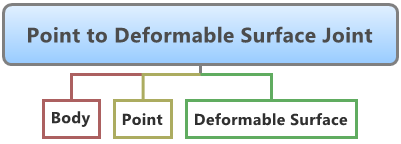Point to Deformable Surface (PTDSF) Joint |

|

|

|

|
|
Point to Deformable Surface (PTDSF) Joint |

|

|

|

|
This section describes the Point to Deformable Surface (PTDSF) Joint entity of MotionView and shows the various usage, creation, and editing methods.
The Point to Deformable Surface Joint constrains a fixed point on a body to slide along a surface that passes through the origins of a specified set of markers. These markers may belong to different bodies. As the markers move in space, the surface is calculated at every time step using CUBIC spline interpolation through the marker origins. Hence, the surface deforms as the markers move about.
The topological information required to define an PTDSF Joint is shown in the figure below:

The data members of the PTDSF Joint can be classified into the following members:
An PTDSF Joint needs the following:
| • | One Body – Body, this is the body that will slide on the Deformable Surface. |
| • | One Point – Point, the initial location of the sliding body on the Deformable Surface. |
| • | One Deformable Surface – DeformableSurface, this is the Deformable Surface to which the sliding body is connected to. |
This advanced joint can only be modeled as a Single entity (it cannot be modeled as a Pair entity).
There are no editable properties for a Point to Deformable Surface Joint.
To learn how to add a Point to Deformable Surface Joint to a model, please see the Joints topic.
Important Note - In order to completely specify a Point to Deformable Surface Joint, the following entities must be created first:
| 1. | One Deformable Surface (created using the Deformable Surface panel |
| 2. | One Body and One Point (to be used as part of the Point to Deformable Surface Joint definition). |
Joints Panel (PTDSF Joint) – Connectivity Tab
This is the point which is to be the initial position of the sliding body.
The PTDSF Joint definition is now complete. |
The Project Browser will filter the entities and display only the Advanced Joints in the model.
The corresponding panel is automatically displayed.
|
The model containing the PTDSF Joint can be saved in MDL format from MotionView and exported in the MotionSolve XML format.
To learn how to create a complete model using MDL Statements, please refer to tutorial MV-1060: Introduction to MDL. |
The PTDSF Joint when exported to the MotionSolve XML format is defined as a Constraint_PTDSF statement. Syntax: <Constraint_PTDSF id = "integer" Label = “Advance Joint Name” i_marker_id = "integer" ref_dsurface_id = "integer" /> In case of the PTDSF Joint the model statement will be as shown below: <Constraint_PTDSF id = "301001" label = "Point to Deformable Surface Joint" i_marker_id = "30111361" ref_dsurface_id = "301001" /> In the above XML Model statement the i_marker_id represents the I marker of the Joint which belongs to Body 1. To understand the complete syntax of the Constraint_PTDSF XML model statement, please refer to the MotionSolve Reference Guide Page for Constraint_PTDSF. |
In MotionView, Tcl can be used to add any MDL entities to the model. There are two Tcl commands that can be used to add an entity:
Syntax: mdlmodel_handle InterpretEntity new_handle keyword varname label In case of the PTDSF Joint the statement will look as shown below: mdlmodel_handle InterpretEntity advjoint PointToDeformableSurfaceJoint aj_ptdsf "\"Point to Deformable Surface Joint\"" b_slb p_slp defsur_s1; |
*This command is not applicable for Point to Deformable Surface joint entities. |
The InterpretEntity command is used to add entities to the model and the InterpretSet command is used to set the entity properties. Extended definitions for InterpretEntity and InterpretSet can be found in the HyperWorks Desktop Reference Guide.
Note - When using the InterpretEntity and InterpretSet commands, it is important to also use the Evaluate command in order for the changes to take effect immediately.
To learn how to create a complete model using Tcl commands, please refer to tutorial MV-1040: Model Building Using Tcl.
See Also:
*PointToDeformableSurfaceJoint (MDL Model Statement)
*DeformableSurface (MDL Model Statement)
Constraint_PTDSF (XML Command)
InterpretEntity (Tcl Command)
InterpretSet (Tcl Command)